For many educators, the end of the school year is quickly approaching and stories about summer quickly fill their classroom library shelves. Summer is a wonderful time to set personal reading goals and to find additional titles to build text sets. It is also the perfect time to visit the public library, bookstore, and online professional resources about literacy and books, such as Summer Reading (2013) edited by Richard Allington and Anne McGill-Franzen. Also consider joining a special interest group, like the Children’s Literature and Reading (CL/R) SIG that produces these weekly sets of book reviews!
As you prepare your end of the year letter to families, you will want to share the Reading Today Online link for recommended books from the CL/R SIG. We hope that the following book suggestions will keep your students motivated to read during the summertime. Another resource to share is the Children’s Choices Reading List. The Children’s Choices is a project cosponsored by the International Reading Association and the Children’s Book Council. Readwritethink.org has several tips and interactive tools to support summer reading this summer, such as Summer Reading Calendar, Poetic Memories of Summer, Summer Trading Cards, or Summer Superheroes.
Grades K-2
Burningham, J. (2014). Picnic. Somerville, MA: Candlewick.
 This charming book functions as an easy reader, picture book, and interactive story book. The black-outlined sketch-like illustrations introduce the characters from the first page then a cumulative style is used to add characters at an accessible pace for new readers. The font is large and clearly placed on white background. The oversized format of the book ensures that readers will not get overwhelmed and will be able to use picture clues. The interactive pages involve directly searching the pictures: “Can you find sheep’s hat?” and “Who is sleeping in which bed?” The child-like drawings have a messy feel to them that will add to reader’s enjoyment of this book. The book mostly consists of double-page spreads with a wordless scene while they eat lunch. The animal characters and playful tone make this a charming read aloud for summer or for any bedtime ritual.
This charming book functions as an easy reader, picture book, and interactive story book. The black-outlined sketch-like illustrations introduce the characters from the first page then a cumulative style is used to add characters at an accessible pace for new readers. The font is large and clearly placed on white background. The oversized format of the book ensures that readers will not get overwhelmed and will be able to use picture clues. The interactive pages involve directly searching the pictures: “Can you find sheep’s hat?” and “Who is sleeping in which bed?” The child-like drawings have a messy feel to them that will add to reader’s enjoyment of this book. The book mostly consists of double-page spreads with a wordless scene while they eat lunch. The animal characters and playful tone make this a charming read aloud for summer or for any bedtime ritual.
- Lesley Colabucci, Millersville University of Pennsylvania
Malnor, Carol. (2014). On Kiki’s Reef. Illus. by Trina Hunter. Nevada City, CA: Dawn Publications.
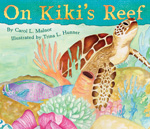 Formerly a teacher, now a writer and blogger, Malnor shares information about a sea turtle’s journey. Kiki, a tiny green sea turtle safely makes it to the ocean to find her home. Eventually, she finds the coral reef and encounters many new inhabitants, such as the clownfish, anemones, grouper, and barracuda. The text contains a brief narrative and a rhyming couplet that provides a brief summary. The beautiful watercolor illustrations provide detailed pictures about the sea life and Kiki’s journey. The sea turtle returns to the beach where she was born to lay eggs. The back matter contains information about the life cycle of a sea turtle as well as information about corals and the other animals featured throughout the text. In addition, the author provides teaching suggestions and resource materials. Teachers will definitely want to partner this book with Into the Sea (1996) by Brenda Guiberson, One Tiny Turtle (2001) by Nicola Davies, Sea Turtles (1995) by Gail Gibbons, Turtle Tide: The ways of Sea Turtles (2005) and Sea Turtle Scientist (2014) by Stephen Swinburne.
Formerly a teacher, now a writer and blogger, Malnor shares information about a sea turtle’s journey. Kiki, a tiny green sea turtle safely makes it to the ocean to find her home. Eventually, she finds the coral reef and encounters many new inhabitants, such as the clownfish, anemones, grouper, and barracuda. The text contains a brief narrative and a rhyming couplet that provides a brief summary. The beautiful watercolor illustrations provide detailed pictures about the sea life and Kiki’s journey. The sea turtle returns to the beach where she was born to lay eggs. The back matter contains information about the life cycle of a sea turtle as well as information about corals and the other animals featured throughout the text. In addition, the author provides teaching suggestions and resource materials. Teachers will definitely want to partner this book with Into the Sea (1996) by Brenda Guiberson, One Tiny Turtle (2001) by Nicola Davies, Sea Turtles (1995) by Gail Gibbons, Turtle Tide: The ways of Sea Turtles (2005) and Sea Turtle Scientist (2014) by Stephen Swinburne.
- Mary Napoli, Penn State Harrisburg
Tan, S. (2014). Rules of Summer. New York, NY: Arthur A. Levine Books.
 The somewhat strange “rules” compiled in this picture book will mesmerize readers as they try to figure out both the pictures and the story. The book begins on the end pages as two boys, alone on a desolate gray street, exchange a secret. The pictures continue to tell the story as the younger boy shares what he learned last summer. The rules may not make sense at first read, but the haunting, surreal pictures will stick with readers in a way that makes the rules unforgettable. Some rules are obviously true, “never give your keys to a stranger,” but complicated by the bizarre picture accompanying them (an oversized cat taking the younger boy’s spot in the house). Other rules are silly or even creepy; “never eat the last olive at a party,” “always bring bolt cutters.” The climax of the vague storyline occurs during a series of wordless double-page spreads, but this is one of those books that truly allows readers to use their imagination to make meaning.
The somewhat strange “rules” compiled in this picture book will mesmerize readers as they try to figure out both the pictures and the story. The book begins on the end pages as two boys, alone on a desolate gray street, exchange a secret. The pictures continue to tell the story as the younger boy shares what he learned last summer. The rules may not make sense at first read, but the haunting, surreal pictures will stick with readers in a way that makes the rules unforgettable. Some rules are obviously true, “never give your keys to a stranger,” but complicated by the bizarre picture accompanying them (an oversized cat taking the younger boy’s spot in the house). Other rules are silly or even creepy; “never eat the last olive at a party,” “always bring bolt cutters.” The climax of the vague storyline occurs during a series of wordless double-page spreads, but this is one of those books that truly allows readers to use their imagination to make meaning.
- Lesley Colabucci, Millersville University of Pennsylvania
Amstutz, L.J. (2014). Bike safety: A crash course. North Mankato, MN: Capstone Press.
 This simple guide to bike safety is perfect for share with young children learning to ride a bike this summer. Most pages contain full-color photographs of cyclists—young and old, parents and children, in neighborhoods and on trails. A broad range of diversity is represented in the photographs. One page contains an illustration of turn signals. The text is straightforward and easy to read. The effective use of headings helps set the tone for the safety advice that is conveyed in each section. The format is consistent throughout the book and the text contains basic language and sentence structure. Back matter includes a glossary, additional resources (books and web-based), and an index.
This simple guide to bike safety is perfect for share with young children learning to ride a bike this summer. Most pages contain full-color photographs of cyclists—young and old, parents and children, in neighborhoods and on trails. A broad range of diversity is represented in the photographs. One page contains an illustration of turn signals. The text is straightforward and easy to read. The effective use of headings helps set the tone for the safety advice that is conveyed in each section. The format is consistent throughout the book and the text contains basic language and sentence structure. Back matter includes a glossary, additional resources (books and web-based), and an index.
- Lesley Colabucci, Millersville University of Pennsylvania
Grades 3-5
Javaherbin, Mina. (2014). Soccer Star. Illus. by Renato Alarcão. Somerville, MA: Candlewick Press.
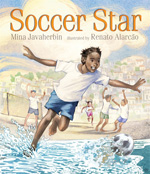 In this beautifully illustrated story, readers meet Paul Marcelo Feliciano (Felino) who likes to play soccer on the beach with his friends in Brazil. He dreams of a day when he will be a famous soccer player and will earn enough money so his mother would not have to work long hours. Felino and his friends sometimes miss school to help earn money for the family. Many of the families live in poverty and must work to help buy basic necessities. Soccer is a sport that instills hope, joy, and togetherness. Each page shows Felino visiting one of his friends where he envisions them flying, soaring, or climbing to success. Felino’s sister Maria practices soccer with him even though girls are not allowed on the soccer team. However, on the day of the big game, one of the team members is injured and Maria is allowed to substitute. This symbolizes potential change in the traditions, and Maria scores a goal! This is a gentle yet powerful story about hope, community, and perseverance. Post-reading conversations about poverty, gender, class, and justice will certainly empower readers to think critically about their world. Teachers will want to visit the author’s blog at http://minajavaherbin.com/ and share her earlier work, Goal! (2010).
In this beautifully illustrated story, readers meet Paul Marcelo Feliciano (Felino) who likes to play soccer on the beach with his friends in Brazil. He dreams of a day when he will be a famous soccer player and will earn enough money so his mother would not have to work long hours. Felino and his friends sometimes miss school to help earn money for the family. Many of the families live in poverty and must work to help buy basic necessities. Soccer is a sport that instills hope, joy, and togetherness. Each page shows Felino visiting one of his friends where he envisions them flying, soaring, or climbing to success. Felino’s sister Maria practices soccer with him even though girls are not allowed on the soccer team. However, on the day of the big game, one of the team members is injured and Maria is allowed to substitute. This symbolizes potential change in the traditions, and Maria scores a goal! This is a gentle yet powerful story about hope, community, and perseverance. Post-reading conversations about poverty, gender, class, and justice will certainly empower readers to think critically about their world. Teachers will want to visit the author’s blog at http://minajavaherbin.com/ and share her earlier work, Goal! (2010).
- Mary Napoli, Penn State Harrisburg
Khan, R. (2014). King for a day. Illus. by Christiane Kromer. New York, NY: Lee & Low Books.
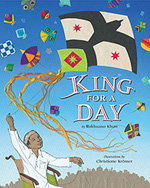 Set in Pakistan, King for a Day tells the story of Malik who plans to capture the most kites during the festival of Basant. Malik works with his brother and sister to battle a bully using Falcon, the kite he made which is “built for speed.” Themes of family, friendship, and bullying are woven together in this believable story that features a variety of multicultural elements, notably the main character’s use of a wheelchair. Often books featuring characters with disabilities fail to allow the character to fully develop; Malik is a realistic, likable character who solves his own problem and makes a difference for others. Interested readers can learn more about the festival in the author’s note at the end of the book. The mixed-media collages add to the authenticity of this multicultural piece.
Set in Pakistan, King for a Day tells the story of Malik who plans to capture the most kites during the festival of Basant. Malik works with his brother and sister to battle a bully using Falcon, the kite he made which is “built for speed.” Themes of family, friendship, and bullying are woven together in this believable story that features a variety of multicultural elements, notably the main character’s use of a wheelchair. Often books featuring characters with disabilities fail to allow the character to fully develop; Malik is a realistic, likable character who solves his own problem and makes a difference for others. Interested readers can learn more about the festival in the author’s note at the end of the book. The mixed-media collages add to the authenticity of this multicultural piece.
- Lesley Colabucci, Millersville University of Pennsylvania
Raczka, Bob. (2014). Joy in Mudville. Illus. by Glin Dibley. Minneapolis, MN: Carolrhoda Books.
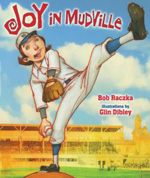 The Mudville Nine baseball team needs a victory. Unfortunately, the Mighty Casey didn’t have an impressive game the day before, so the coach is trying a new relief pitcher. The pitcher, Joy, happens to be a “she” (p. 8). She proves that anyone with some skill can play sports when given the chance. Through short stanzas, the story follows Joy through her unique pitching style as she helps the Mudville team win the game. The illustrations capture the characters’ expressions and Joy’s various pitching styles. The back matter includes the original poem, “Casey at Bat” by Ernest Thayer. Partner with Thayer’s Casey at Bat: A Ballad of the Republic Sung in the Year 1888 (2000), David Adler’s Mama Played Baseball (2003), Audrey Vernick’s She Loved Baseball: The Effa Manley Story (2010), Shana Corey’s Players in Pigtails (2003), Angela Johnson’s Just like Josh Gibson (2004), and Deborah Hopkinson’s Girl Wonder: A Baseball Story in Nine Innings (2003).
The Mudville Nine baseball team needs a victory. Unfortunately, the Mighty Casey didn’t have an impressive game the day before, so the coach is trying a new relief pitcher. The pitcher, Joy, happens to be a “she” (p. 8). She proves that anyone with some skill can play sports when given the chance. Through short stanzas, the story follows Joy through her unique pitching style as she helps the Mudville team win the game. The illustrations capture the characters’ expressions and Joy’s various pitching styles. The back matter includes the original poem, “Casey at Bat” by Ernest Thayer. Partner with Thayer’s Casey at Bat: A Ballad of the Republic Sung in the Year 1888 (2000), David Adler’s Mama Played Baseball (2003), Audrey Vernick’s She Loved Baseball: The Effa Manley Story (2010), Shana Corey’s Players in Pigtails (2003), Angela Johnson’s Just like Josh Gibson (2004), and Deborah Hopkinson’s Girl Wonder: A Baseball Story in Nine Innings (2003).
- Mary Napoli, Penn State Harrisburg
Ross, Catherine Sheldrick. (2014). Shapes in math, science, and nature: Squares, triangles, and circles. Illus. by Bill Slavin. Tonawanda, NY: Kids Can Press.
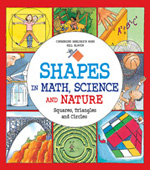 Fight the summer slide for reading and math! This impressive concept book is ideal for intermediate readers. It discusses the three basic shapes and their significance in math and science. The author provides simple definitions with real life applications to the world. Each section contains puzzles and hands-on activities to invite readers to explore and discover new information. A few of the activities include making a cube, pentominoes, a moebius strip, circle prints, and triangle trees. There is also information about the history of the shape, shape-related games, and interdisciplinary connections for home or classroom. The back matter with mathematical formulas, a glossary, and index makes this an outstanding resource to support content area connections.
Fight the summer slide for reading and math! This impressive concept book is ideal for intermediate readers. It discusses the three basic shapes and their significance in math and science. The author provides simple definitions with real life applications to the world. Each section contains puzzles and hands-on activities to invite readers to explore and discover new information. A few of the activities include making a cube, pentominoes, a moebius strip, circle prints, and triangle trees. There is also information about the history of the shape, shape-related games, and interdisciplinary connections for home or classroom. The back matter with mathematical formulas, a glossary, and index makes this an outstanding resource to support content area connections.
- Mary Napoli, Penn State Harrisburg
Grades 6-8
Cervantes, Jennifer. (2014). Tortilla Sun. San Francisco, CA: Chronicle Books.
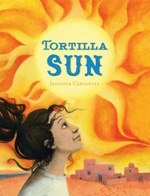 Tortilla Sun is a beautifully written story of a young girl’s search for answers and of her learning to appreciate her family’s culture. When we meet 12-year-old Izzy, we learn that she loves to write stories and that her teacher encouraged her to record her ideas using story cards. One day, while rummaging through boxes, she finds a baseball with a faded message. She knows that this belonged to her father who died when she was very young, but every time she asks questions about her father’s character, her mother changes the subject. Izzy is sent to spend the summer with her grandmother (Nana) in a small village in New Mexico, where she was born. It is here where she discovers the beauty of her culture, forms new friendships, learns about loss, death, acceptance, and forgiveness. Through the help of clues and trusting her surroundings, she learns the truth about her father and uncovers the mystery behind the “love is magic” message. Each new discovery provides new opportunities for Izzy’s writing. Her story is inspired by new understandings about life and friendship. Author Jennifer Cervantes weaves magical realism and rich visual descriptions that take readers on Izzy’s journey. She includes an author’s note further describing her rich Hispanic culture. She also shares her Nana’s flour tortilla recipe and a glossary. The author provides a video demonstration of making the tortillas and includes a reader’s guide at her website www.jennifercervantes.com.
Tortilla Sun is a beautifully written story of a young girl’s search for answers and of her learning to appreciate her family’s culture. When we meet 12-year-old Izzy, we learn that she loves to write stories and that her teacher encouraged her to record her ideas using story cards. One day, while rummaging through boxes, she finds a baseball with a faded message. She knows that this belonged to her father who died when she was very young, but every time she asks questions about her father’s character, her mother changes the subject. Izzy is sent to spend the summer with her grandmother (Nana) in a small village in New Mexico, where she was born. It is here where she discovers the beauty of her culture, forms new friendships, learns about loss, death, acceptance, and forgiveness. Through the help of clues and trusting her surroundings, she learns the truth about her father and uncovers the mystery behind the “love is magic” message. Each new discovery provides new opportunities for Izzy’s writing. Her story is inspired by new understandings about life and friendship. Author Jennifer Cervantes weaves magical realism and rich visual descriptions that take readers on Izzy’s journey. She includes an author’s note further describing her rich Hispanic culture. She also shares her Nana’s flour tortilla recipe and a glossary. The author provides a video demonstration of making the tortillas and includes a reader’s guide at her website www.jennifercervantes.com.
- Mary Napoli, Penn State Harrisburg
Hurwitz, Michele Weber. (2014). The summer I saved the world…in 65 days. New York, NY: Wendy Lamb Books.
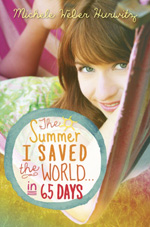 What would happen if you tried to change the world in 65 days? In this wonderful middle-grade novel, readers meet Nina, a thirteen year-old girl who is still mourning the loss of her grandmother. Her parents are occupied with their jobs as high-profile lawyers, and her older brother is busy working. She is also drifting apart from her best friend, Jorie, who is now interested in make-up, clothes, and boys, specifically her neighbor Eli. Nina remembers the advice of her eighth grade teacher, “It is very often the ordinary things go unnoticed that end up making a big difference. As you embark upon your high school careers, be unnoticed, but be remarkable” (p. 6). She gets the idea to do one nice thing every single day during the summer. She starts by planting marigolds in Mrs. Chung’s garden since she is walking around in a cast. On a daily basis, Nina demonstrates simple acts of kindness for her neighbors and family in her suburban cul-de-sac community. Throughout this experience, she discovers feelings for Eli and learns that even other families have problems of their own. She also develops a better understanding about herself, her parents and her brother. The novel is punctuated with her grandmother’s simple truths (ST), things that happen when they are meant to happen. Nina’s good deeds help to bring the community together in an inspirational way. The publisher includes an excellent book trailer to share with readers before reading, and the author includes an interactive map of Nina’s neighborhood on her web site.
What would happen if you tried to change the world in 65 days? In this wonderful middle-grade novel, readers meet Nina, a thirteen year-old girl who is still mourning the loss of her grandmother. Her parents are occupied with their jobs as high-profile lawyers, and her older brother is busy working. She is also drifting apart from her best friend, Jorie, who is now interested in make-up, clothes, and boys, specifically her neighbor Eli. Nina remembers the advice of her eighth grade teacher, “It is very often the ordinary things go unnoticed that end up making a big difference. As you embark upon your high school careers, be unnoticed, but be remarkable” (p. 6). She gets the idea to do one nice thing every single day during the summer. She starts by planting marigolds in Mrs. Chung’s garden since she is walking around in a cast. On a daily basis, Nina demonstrates simple acts of kindness for her neighbors and family in her suburban cul-de-sac community. Throughout this experience, she discovers feelings for Eli and learns that even other families have problems of their own. She also develops a better understanding about herself, her parents and her brother. The novel is punctuated with her grandmother’s simple truths (ST), things that happen when they are meant to happen. Nina’s good deeds help to bring the community together in an inspirational way. The publisher includes an excellent book trailer to share with readers before reading, and the author includes an interactive map of Nina’s neighborhood on her web site.
- Mary Napoli, Penn State Harrisburg
Grades 9-12
Lockhart, E. (2014). We Were Liars. New York, NY: Delacorte Press.
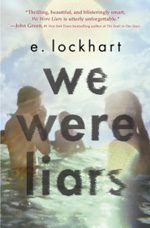 This young adult novel will leave have readers clinging to every word and holding their breath as they turn the pages. Candace Sinclair Eastman spends her summers with family on a Massachusetts island owned by her grandfather. Candace’s summers are marked by long days at the beach with her age-mate cousins, Mirren and Johnny; short boats trips to the mainland for fudge; family dinners with the younger cousins; and a romance with Gat, the nephew of Aunt Carrie’s boyfriend. After the death of her grandmother, fighting breaks out among the three daughters in this “old money” family. This conflict leads to series of events that leave Candace questioning her privilege and confused about her own values and experience. Lockhart’s prose from Candace’s perspective is hard hitting so the intermingled fairy tale vignettes are a welcome relief as readers await the climactic ending.
This young adult novel will leave have readers clinging to every word and holding their breath as they turn the pages. Candace Sinclair Eastman spends her summers with family on a Massachusetts island owned by her grandfather. Candace’s summers are marked by long days at the beach with her age-mate cousins, Mirren and Johnny; short boats trips to the mainland for fudge; family dinners with the younger cousins; and a romance with Gat, the nephew of Aunt Carrie’s boyfriend. After the death of her grandmother, fighting breaks out among the three daughters in this “old money” family. This conflict leads to series of events that leave Candace questioning her privilege and confused about her own values and experience. Lockhart’s prose from Candace’s perspective is hard hitting so the intermingled fairy tale vignettes are a welcome relief as readers await the climactic ending.
- Lesley Colabucci, Millersville University of Pennsylvania
Tamaki, M. & Tamaki, J. (2014). This one summer. New York, NY: First Second.
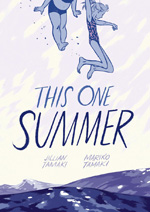 Set during summer vacation at Awago Beach, this coming-of-age story in graphic novel format features blue-toned illustrations and authentic dialogue. Rose and Windy have been “summer cottage friends” since they were five years old and the story begins with them reuniting, picking up where they left off for care-free summer fun. As the story unfolds, conflict within Rose’s family and Rose’s own internal conflicts related to her burgeoning adolescence shift the theme from lazy days of summer to the difficulties teens face as they begin to see their parents and themselves from new, often painful, perspectives. Readers will find the dialogue engaging and realistic (“Soooooo, do you have a boyfriend? Do you like anybody? Like seriously like anybody?”) while both the paneled pages and the quieter double-page spreads will keep their attention focused on the plot.
Set during summer vacation at Awago Beach, this coming-of-age story in graphic novel format features blue-toned illustrations and authentic dialogue. Rose and Windy have been “summer cottage friends” since they were five years old and the story begins with them reuniting, picking up where they left off for care-free summer fun. As the story unfolds, conflict within Rose’s family and Rose’s own internal conflicts related to her burgeoning adolescence shift the theme from lazy days of summer to the difficulties teens face as they begin to see their parents and themselves from new, often painful, perspectives. Readers will find the dialogue engaging and realistic (“Soooooo, do you have a boyfriend? Do you like anybody? Like seriously like anybody?”) while both the paneled pages and the quieter double-page spreads will keep their attention focused on the plot.
- Lesley Colabucci, Millersville University of Pennsylvania
Rubin, S.G. (2014). Freedom summer: The 1964 struggle for civil rights in Mississippi. New York, NY: Holiday House.
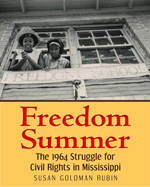 This book takes a chronological approach to the content with some chapters treating the daily unfolding of events such as, “Chapter Three: June 21, 1964, Afternoon” to others providing a weekly perspective such as “Chapter Eleven: July and early August, 1964.” The book tells the story of the activism and struggle that led to the 1965’s Voting Rights Act. Readers will learn about the murders of three civil rights field workers, voter registration campaigns, and the role of the freedom schools within the movement. The voice of Fannie Lou Hamer and images of everyday life and everyday people are emphasized in a memorable way. The back matter begins with a section titled “The Story Continues…” and includes websites, places to visit, a timeline, appendices with archival material, meticulous source notes and picture credits, and a bibliography and index.
This book takes a chronological approach to the content with some chapters treating the daily unfolding of events such as, “Chapter Three: June 21, 1964, Afternoon” to others providing a weekly perspective such as “Chapter Eleven: July and early August, 1964.” The book tells the story of the activism and struggle that led to the 1965’s Voting Rights Act. Readers will learn about the murders of three civil rights field workers, voter registration campaigns, and the role of the freedom schools within the movement. The voice of Fannie Lou Hamer and images of everyday life and everyday people are emphasized in a memorable way. The back matter begins with a section titled “The Story Continues…” and includes websites, places to visit, a timeline, appendices with archival material, meticulous source notes and picture credits, and a bibliography and index.
- Lesley Colabucci, Millersville University of Pennsylvania
These reviews and resources are submitted by members of the International Reading Association’s Children’s Literature and Special Interest Group (CL/R SIG) and are published weekly on Reading Today Online.
The International Reading Association partners with the National Council of Teachers of English and Verizon Thinkfinity to produce ReadWriteThink.org, a website devoted to providing literacy instruction and interactive resources for Grades K–12.